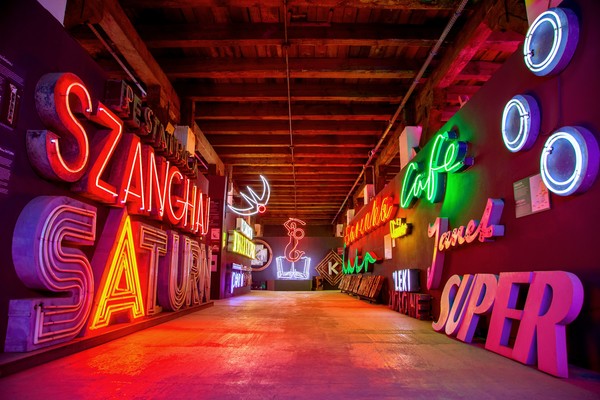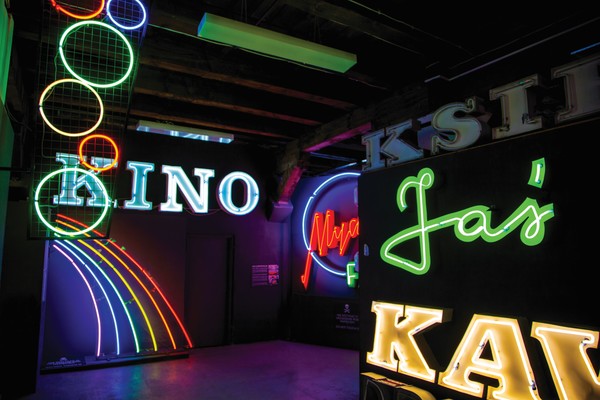
[아츠앤컬쳐] 폴란드 바르샤바에 위치한 ‘네온 박물관’은 냉전시대의 네온사인과 전자 그래픽 디자인의 보존 및 문서화에 전념하고 있는 곳이다.
2005년부터 네온 박물관은 구 유럽 동구권 전역에서 한때 열풍이었던 ‘네오니세이션’ 캠페인의 마지막 잔재를 구하고 보존하는 작업에 쉬지 않고 참여해왔다. 이러한 지속적 노력 덕분에 유럽 최초이자 유일한 ‘네온 박물관’은 폴란드 전역에 네온 르네상스를 불러온 공로를 인정받았다.
네온은 ‘정보, 교육, 즐거움’ 그 이상이었다. 더 높은 사회문화적 목적을 충족해야 했고 현대성을 자신 있게 표현해야 했다. 한동안은 도시 거리의 ‘네오니세이션’이 경제적∙문화적 부흥을 불러일으켰다. 비록 국가가 지정한 엄격한 규칙과 규정의 틀 내에서 작업했지만, 각 국가의 그래픽 아티스트들은 자신만의 아방가르드 디자인 언어를 만들어냈고 반짝이는 빛의 실들로 작품을 창작해냈다. 수십 년 동안 놀라운 네온 디자인과 새로운 글자체, 그리고 재치 있는 기호들이 밤하늘을 빛내며 스탈린 시대의 암울한 흔적을 모두 불태웠다.

그러나 구 유럽 동구권의 신생 민주주의 정부는 서구에 다시 합류하고자 서두르며, 눈에 띄는 기존 소련 공산주의 점령의 상징들을 제거해나가고자 하였다. 네온 간판은 정치적으로 퇴행적일 뿐만 아니라 유지관리 비용도 감당할 수 없다고 여겨졌기에 대규모 청소의 첫 번째 희생자 중 하나였다. 현재 문화적으로나 역사적으로 중요한 의미를 가지는 전자 그래픽 기호들은 대부분 당시의 ‘대규모 제거 계획’으로 인해 사라진 것이며, 이후 거리에는 다시 스탈린 시대를 연상케 하는 암울한 분위기가 조성되었다.
사진작가 ‘일로나 카르빈스카’와 박물관 공동디렉터인 ‘데이비드 힐’의 실행력 덕분에 중부 및 동부 유럽 디자인 역사에 이 사실이 기록될 수 있었다. 네온사인의 역사가 점차 희미해지면서, 이 둘은 10년 이상 폴란드와 구 동구권 전역을 돌아다니며 마지막으로 남은 네온사인들을 사진으로 기록하였고 많은 경우는 한때 거대했던 ‘네오니세이션’ 캠페인의 일환으로 복구작업이 진행되었다.
즉, 이 획기적인 사진 기록 프로젝트는 결국 유럽 최초이자 유일한 바르샤바 네온 박물관이 시작한 것이다. 인류 역사상 가장 흥미롭지만 지금껏 세상에 잘 알려지지 않았던 이데올로기적, 문화적 갈등에 대한 기록들을 눈부신 빛을 통해 보여준다.
네온 박물관은 역사와 예술이 만나고, 어둠과 빛이 만나는 특별한 박물관이다.
번역 : 권하연 주한 폴란드 대사관 공공외교팀

The Neo Museum in Warsaw
The Neon Muzeum in Warsaw Poland is dedicated to the documentation and the preservation of Cold War era Neon Signs and Electro-Graphic Design.
Since 2005, our institution has been tirelessly engaged in the enormous task of saving, documenting and preserving the last surviving remnants of the once-great State 'neonisation' campaign across the former Eastern Bloc. The museum’s ongoing efforts have been credited with ushering in a neon renaissance throughout Poland; a movement which began with the opening of the first-and-only museum of its kind in Europe - the Neon Muzeum !
This new ‘neon’ was to “inform, educate, amuse” and more – it had to possess and fulfil a higher socio-cultural purpose and confidently express modernity. For a while at least, ‘neonisation’ of the city streets created a sense of an economic and cultural revival in full swing. Although working within a rigid framework of state designated rules and regulations, graphic artists in their respective countries spawned their own vernacular of avant-garde design and often fashioned unbridled creations in shimmering threads of light. For decades, astonishing neon designs, new letterforms and often witty semaphores, shone out in the night sky – burning away all traces of Stalin-era gloom.

The fledgling democratic governments of the former Eastern Bloc set about purging conspicuous symbols of Soviet then communist occupation. Deemed politically regressive, but also simply unaffordable to maintain, neon signage was one of the first victims of this massive purge. Untold numbers of now culturally and historically significant electro-graphic symbols were destroyed in what was known as the ‘great recycling scheme’. This purge returned a heavy Stalin-era gloom to the streets.
Almost nothing would be known of this astonishing chapter in Central and Eastern European 20th century design history, were it not for the actions of photographer Ilona Karwińska and the museum’s co-director. As the last surviving neon signs were flickering into obscurity, Ilona Karwińska and partner David Hill - also co-director - travelled throughout Poland and the former Eastern Bloc for more than a decade, documenting and photographing – and in many cases salvaging – the last remnants of a once-grand ‘neonisation’ campaign.
This groundbreaking photographic documentation project eventually led to the formation of Europe’s first and only Neon Muzeum in Warsaw. The museum presents in dazzling light, the unique and untold story of one of human history’s most fascinating ideological and cultural conflicts.
The Neon Muzeum is a museum like no other - where history meets art, and darkness meets light !
주한폴란드대사관 제공

